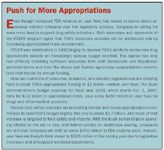Paying for Safety
Pharmaceutical Executive
As expected, must-pass legislation to reauthorize the Prescription Drug User Fee Act (PDUFA IV) has provided a vehicle to renew numerous programs and to establish new policies to ensure the safe use of medications. The measure implements a user-fee agreement issued in January 2007 as well as a similar user-fee plan for medical devices. It also continues incentives for sponsors to study pediatric uses of drugs and devices and gives FDA authority to require postapproval studies. Manufacturers will have to disclose more information about ongoing clinical trials and research results and must revise product labels within a set time frame. There is more funding for FDA oversight of postmarket drug use and for agency information systems. And manufacturers of more risky medications will have to adopt a range of pharmacovigilance activities to ensure appropriate product use.
As expected, must-pass legislation to reauthorize the Prescription Drug User Fee Act (PDUFA IV) has provided a vehicle to renew numerous programs and to establish new policies to ensure the safe use of medications. The measure implements a user-fee agreement issued in January 2007 as well as a similar user-fee plan for medical devices. It also continues incentives for sponsors to study pediatric uses of drugs and devices and gives FDA authority to require postapproval studies. Manufacturers will have to disclose more information about ongoing clinical trials and research results and must revise product labels within a set time frame. There is more funding for FDA oversight of postmarket drug use and for agency information systems. And manufacturers of more risky medications will have to adopt a range of pharmacovigilance activities to ensure appropriate product use.

Jill Wechsler
More Fees for Services
In adopting PDUFA IV, Congress boosts the annual fees paid by pharma to adjust for inflation and the increased cost of overseeing the drug-development-and-review process in an efficient and timely fashion. FDA and industry initially agreed on a fee program that would collect nearly $400 million in 2008, with steady increases over the program's five-year period.
A new fee program also bolsters FDA review of direct-to-consumer (DTC) broadcast drug advertising, as discussed in Leading Indicators, April 2007. Some members of Congress sought to ban consumer advertising of new drugs for some months or years after coming to market, noting that even a more efficient and comprehensive review of DTC ads would remain voluntary. Instead, the legislators agreed to authorize stiffer fines and penalties for companies that fail to ensure the accuracy and fair balance of drug ads. All parties will be watching closely to see if misleading commercials aggravate drug safety concerns.
Some of the PDUFA increases will be used to expand drug safety oversight and assessment throughout a product's life cycle—and not just during the first two or three years after product approval, as currently allowed. The payments will support additional staffers in FDA's Office of Surveillance and Epidemiology in the Center for Drug Evaluation and Research and enhance the safety office's role in evaluating postapproval risk information and labeling changes. One specific project is to improve FDA's system for assessing proposed product names, which aims to reduce medication errors from look-alike and sound-alike names.
Congress is raising the fees even more to support these and other initiatives. And FDA will need all the added fee revenues the legislators provide because its appropriated funding is barely keeping up with inflation (see "Push for More Appropriations").

Push for More Appropriations
Managing Risks
One of the legislators' pet provisions permits FDA to require companies to develop a Risk Evaluation and Mitigation Strategy (REMS) to ensure safe use of particularly high-risk drugs. Initially, the legislators wanted to require a REMS for all new drugs but agreed with manufacturers that such a broad mandate could waste time and resources if applied to relatively safe products.
Manufacturers may submit a REMS plan in a new or supplemental application, or FDA may require such a process based on new safety signals for marketed products. A REMS would evaluate the need to:
•conduct additional postapproval studies and clinical trials
•require labeling changes to disclose new safety concerns
•prepare and distribute a Medication Guide or patient package insert
•develop a communication plan for disseminating additional information to healthcare professionals
•seek FDA prereview of advertising and marketing materials to ensure that ads describe serious risks appropriately and fairly
•limit drug prescribing and distribution. FDA may determine that certain treatments should be prescribed only by specially trained health professionals and only to certain patients. Distribution similarly may be limited to select wholesalers and pharmacists. Additional laboratory testing, patient monitoring, and/or patient enrollment in a registry may be required.
In addition to authorizing REMS, the legislation gives FDA authority to expand safety requirements for all drugs. Sponsors will have to submit more information about ongoing clinical trials to the clinicaltrials.gov Web site and publicly disclose study results, as described in Pharm Exec news last month. Other provisions that fall under the drug safety umbrella include:
•Speedy labeling changes. Under current policy, discussions between sponsors and FDA about label revisions may take months, or even years. The legislation sets time frames for negotiating such changes, including the need for black-box warnings and additional information on contraindications, precautions, or adverse reactions. The system provides a process for sponsors to question a requested change and for resolving disputes. But if FDA insists on new labeling language, it will have more teeth to compel compliance.
•Timely completion of postapproval studies. FDA now may request additional clinical trials and analysis following approval of a new drug, but it lacks authority to levy penalties on companies that fail to complete studies as expected. Sponsors claim that many studies that seem reasonable when a new product is approved for market later appear inappropriate, and many projects have trouble enrolling patients in trials after a drug becomes widely available. The new policy calls for discussion of postapproval study options earlier in the approval process to ensure that agreements are realistic and address important issues. FDA also can request more postapproval studies after a drug is on the market. Manufacturers will propose timetables for completing studies, report periodically on their progress, and explain why they cannot meet set goals—and why they should not be penalized for delays.
Curbs on conflicts-of-interest. The legislation reflects Congressional concerns that too many members of FDA advisory committees have financial links to industry. Although policymakers recognize that these panels can benefit from input from well-known experts, despite any conflicts, the legislation aims to make advisory committees more objective on safety issues by limiting use of waivers to permit such testimony. Congress also wants FDA to more actively solicit scientists and medical experts without financial ties to pharmaceutical companies to improve the advisory process.
Expanding Information
A prime initiative for reducing drug safety problems is to modernize FDA's electronic information system. User fees have supported improvements in the agency's IT infrastructure for new drug review and oversight; now PDUFA IV will provide added resources to establish an all-electronic regulatory submission-and-review environment over the next five years. The envisioned system will allow manufacturers to send in applications electronically with automated cross-links to previously submitted data, and FDA reviewers will be able to retrieve all relevant submissions and utilize tools for searching and analyzing data.
A modern IT system also would improve FDA's current adverse event reporting system (AERS) for collecting and analyzing AERs from manufacturers, health professionals, and patients. Congress also supports FDA efforts to build a more robust active surveillance system instead of relying on spontaneous reports to signal problems. Additional resources will permit FDA to contract with government health programs and private health plans to access population-based epidemiological data on millions of patients that can better inform postmarketing drug surveillance. Expanded collaboration with payers, academics, and the Centers for Education and Research on Therapeutics will enable FDA to learn more about how a drug works in real-world postmarket circumstances, including the extent and outcomes of off-label drug uses.
Jill Wechsler is Pharmaceutical Executive's Washington correspondent. She can be reached at jwechsler@advanstar.com

Addressing Disparities in Psoriasis Trials: Takeda's Strategies for Inclusivity in Clinical Research
April 14th 2025LaShell Robinson, Head of Global Feasibility and Trial Equity at Takeda, speaks about the company's strategies to engage patients in underrepresented populations in its phase III psoriasis trials.
Beyond the Prescription: Pharma's Role in Digital Health Conversations
April 1st 2025Join us for an insightful conversation with Jennifer Harakal, Head of Regulatory Affairs at Canopy Life Sciences, as we unpack the evolving intersection of social media and healthcare decisions. Discover how pharmaceutical companies can navigate regulatory challenges while meaningfully engaging with consumers in digital spaces. Jennifer shares expert strategies for responsible marketing, working with influencers, and creating educational content that bridges the gap between patients and healthcare providers. A must-listen for pharma marketers looking to build trust and compliance in today's social media landscape.